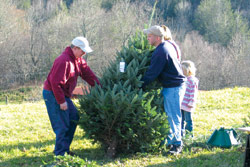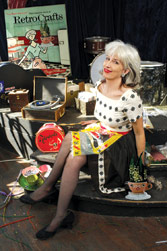Artificial trees made to look real are always tacky. But earlier this millennium, the thirst for ultra-tacky retro fakes, in particular mid-century-modern aluminum trees, began to elevate kitsch to the rank of spirit.

For staunch traditionalists
• Through Jan. 8, tour rooms at Smith-McDowell House Museum that are meticulously decorated in a century's worth of various eras. For more information about "A Victorian Christmas Celebration," see www.wnchistory.org or call (828) 253-9231.
• Besides its annual gingerbread-house display, which can be viewed free Monday through Thursday, the Grove Park Inn also offers a "Christmas Memories and More" package including inn tours, movies, concerts and children's entertainment; see www.groveparkinn.com.
In other words, if you managed to score a real-deal vintage tinsel tree on eBay and could hew savvily to period ornamentation, you could count yourself as festive as any DIY doyenne who wove her own pine wreaths while baking wheat-free gingerbread.
Except that last year, big-box craft store Michael's started selling numerous new interpretations of old-school tinsel trees. Which means they're about to join the ranks of real-looking fakes, becoming as drearily middlebrow as inflatable rooftop Santas.

For subversive traditionalists
by Suzie Millions
Can't decide whether to go tinsel-tree or tannenbaum? Have it both ways with aluminum-foil icicles, created by Asheville author/craft maven Suzie Millions.
Materials
Tin foil (regular foil, 75' roll in 12" width) Plastic lace (the clear-sparkly kind works well)
White glue in a paper cup (or an old detergent bottle cap)
Glitter (your choice: chunky white, silver, iridescent)
Iridescent plastic snowflakes (optional)
Tools
Scissors
Sharpie or other marker
1" foam brush for glue
1) Tear off tinfoil in short strips, roughly between 4" and 7".
2) Cut each piece in half widthwise, so every piece is 6" wide.
3) For each piece of foil, roll one of the shorter edges around the uncapped end of a marker (with the capped end sticking out so you can remove the marker when you're done), continuing to roll until the foil piece is a sparkly silver cigar shape.
4) Pinch one end to a point, then roll that end gently between your hands to graduate the width, making a sparkly silver carrot shape.
5.) Press your carrot in here and there, and pinch it in places, to help make it more like an icicle and less like a carrot.
6.) Smooth out the rough edges on the larger end of the icicle by gently pressing them down toward the center, one finger-width at a time.
7) Brush a little white glue on the top third of the icicle and finish it off with the sparkly stuff of your choice. I like to shake on chunky white glitter, then roll the icicle in a bowl of large iridescent snow flakes (usually sold in the aisle with Buffalo snow and snow-village supplies).
8) Use a scissors blade to poke a hole through each icicle, about 1/2 an inch from the top.
9) Cut a 15' length of plastic lace. Tie a knot about 3 inches from the end. Slip the lace through the icicle and carefully pull the icicle to rest over the knot.
10. Tie a knot in the lace about 3" from the threaded icicle. Pull another icicle on, and continue knotting and threading until you're within a few inches from the end of the lace. The knots should hold the icicles in place. If you find your icicles slipping, tie double knots, or pinch the icicles a little by the holes to help keep them in place.
There's lots of room for variation here. You might like to roll the foil over a variety of objects to vary the thickness of the icicles. Or use a more colorful plastic lacing to string them on, or a different material altogether. I avoid yarn because it tends to be saggy. Make as many garlands as you need to decorate your tree, figuring on about 60' of garland for a 6' tree.
Enter real trees … again. Until very recently, traditional axed Fraser firs were frowned upon for their negative environmental impact, due to the resources needed to farm them and the inevitable question of disposal. Live trees that were actually still alive, i.e. with root balls, were one trendy alternative. But their price was prohibitive.
And then there is this: Fake trees, while re-usable for more than one season, tend to look battered and wan within a few years—and then survive for epochs in a landfill.
Factoids put forth by pickyourownchristmastree.org include the claims that Christmas-tree farms "provide a habitat for wildlife and remove dust and pollen from the air," and that, if properly recycled, trees can be "used to make sand and soil-erosion barriers" or "placed in ponds for fish shelter."
The WNC high country is the Christmas-tree capital of the East, second only behind Oregon in national tree production and an increasingly popular destination for those regional families who want the experience of selecting their own tree for supreme freshness (farm workers do the actual chopping). In this, the N.C. Christmas Tree Association's 50th year, growers all over the Boone area together with local inns are offering package deals for weekenders — or, at the very least, hot chocolate for day-trippers.
The organization's executive director, the advantageously named Jennifer Greene, points out some of the further evils of fakes. Besides not being biodegradable, artificial trees "are often made with leaded metal and oil-based petroleum paints," she says. Greene also extols the virtues of the Fraser fir, including its superior needle retention. High-country farms are harvesting trees in an increasing range of sizes, from 3 to 35 feet, she says.
And also, you know, they smell pretty nice.
For information on choose-and-cut programs, see www.ncchristmastrees.com or call (800) 562-8689.


